In today’s world, events unfold rapidly, and information is flooding our lives from every direction. With the rise of social media, fake news spreads like wildfire, making it increasingly difficult to distinguish truth from fiction. We seek to understand what is happening in the world and what truly matters, yet fragmented information alone cannot provide the answers. Instead, we need a way to step back and gain a broader perspective.
Through my exploration of books, research, and deep contemplation, I have identified three key perspectives that are essential for understanding and making sense of the world. By integrating these three viewpoints, we can uncover the fundamental nature of complex phenomena that often seem elusive.
1. Fiction – Yuval Noah Harari
Yuval Noah Harari, in Sapiens: A Brief History of Humankind, argues that one of the greatest forces driving human progress is our ability to create and believe in fiction. Fiction, in this context, refers to things that do not physically exist but are sustained through collective belief and imagination.
For instance, nations, religions, money, laws, and corporations—many of the things we take for granted as real—are not physical entities but shared fictions that exist because people collectively believe in them. Money, for example, is nothing more than pieces of paper or digital records, yet its value persists because of collective trust. Similarly, nations do not have tangible physical borders; they exist because people uphold them through shared narratives.
Understanding fiction allows us to critically examine societal structures and recognize how beliefs and systems are constructed and sustained. By questioning these narratives, we gain a deeper insight into why certain institutions and values persist.
2. Domains of Objects – Markus Gabriel
Markus Gabriel, in Why the World Does Not Exist, challenges the very notion of “the world” as a singular, all-encompassing entity. Traditionally, we assume that “the world” includes everything that exists. However, to verify this claim, one would need an external vantage point from which to observe everything. But if the world includes everything, no such external perspective exists—leading Gabriel to conclude that the world does not exist.
Instead of a single unified world, Gabriel proposes that reality consists of multiple overlapping domains of objects. Each domain—such as economics, politics, science, or art—operates with its own set of rules and frameworks. There is no singular perspective that encapsulates everything; rather, reality is a collection of domains that coexist and intersect.
This perspective encourages us to move away from reductionist thinking and embrace a multi-faceted understanding of the world. Rather than seeking a singular explanation, we acknowledge the richness and complexity of reality, recognizing that different viewpoints contribute uniquely to our comprehension.
3. Relations – Carlo Rovelli
Carlo Rovelli, in Helgoland: Making Sense of the Quantum Revolution, argues that the world is not made up of independent, self-contained entities but is fundamentally composed of relations. This idea stems from quantum mechanics, where particles do not have fixed properties until they are observed. Instead, they exist only in relation to other particles and measurement processes.
Expanding this principle to the macroscopic world, Rovelli suggests that nothing exists in absolute isolation; everything is defined by its relationships. In The Order of Time, he further develops this concept, asserting that reality is a network of interrelated perspectives, with no external, objective vantage point from which to describe it.
This aligns closely with Markus Gabriel’s idea that the world is a composition of distinct domains rather than a singular entity. By adopting a relational view, we can better appreciate how everything in the world is interconnected, and that existence itself is shaped through interactions and contexts.
4. The Loop of Fiction, Domains, and Relations
The three perspectives—fiction, domains, and relations—do not exist in isolation but interact in a continuous loop, shaping how we interpret and engage with the world.
- Fiction Creates Domains
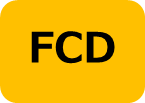 – Humans use fiction to define domains of objects. For example, the concept of “money” as a form of value enables the domain of economics to exist.
– Humans use fiction to define domains of objects. For example, the concept of “money” as a form of value enables the domain of economics to exist. - Domains Establish Relationships
 – Within a defined domain, entities interact according to specific rules and structures. In economics, money determines the relationships between businesses, consumers, and governments.
– Within a defined domain, entities interact according to specific rules and structures. In economics, money determines the relationships between businesses, consumers, and governments. - Relationships Reshape Fiction
 – As relationships evolve, they can alter the narratives that underpin domains. For instance, the rise of digital currencies has changed our understanding of what money is, rewriting the fiction that supports the economic domain.
– As relationships evolve, they can alter the narratives that underpin domains. For instance, the rise of digital currencies has changed our understanding of what money is, rewriting the fiction that supports the economic domain.
This cycle—fiction → domain → relation → fiction—drives the continuous evolution of human understanding and society.
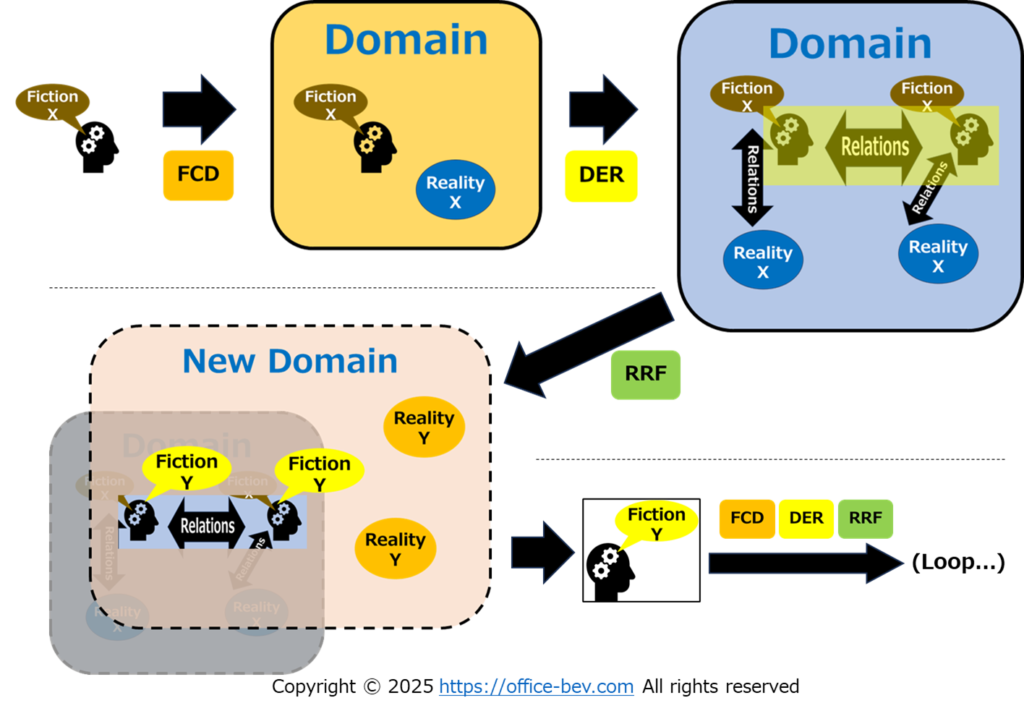
5. The Disruptive Force of Domain Jumps
While this loop generally sustains itself, significant shifts occur when a domain jump takes place. A domain jump happens when a concept or entity leaves its original domain and integrates into a new one, fundamentally altering the cycle. There are two primary ways this occurs:
- Rewriting the fiction that defines a domain
- Example: In the past, “physical reality” was defined strictly as measurable, tangible objects. However, by recognizing that beliefs exist within the human brain, fiction was redefined as part of physical reality, leading to a domain jump where fiction itself became part of the domain of physical existence.
- Establishing new relationships across domains
- Example: Suppose domain A consists of “economic transactions” and domain B consists of “social interactions.” Traditionally, these two domains operated separately. However, the rise of the sharing economy (e.g., Airbnb, Uber) merged economic and social domains by redefining ownership and service relationships, creating a new hybrid domain.
6. Concrete Examples of Domain Jumps
Example A: Redefining the Boundaries of Physical Reality
Initially, the domain of “physical reality” was limited to measurable, tangible objects. Fictional constructs, such as myths or economic systems, were considered external to this domain.
Before:
- “Physical reality” = measurable entities (atoms, energy, etc.).
- “Fiction” = intangible, abstract concepts (myths, money, nations) → Outside the domain.
However, by introducing the narrative that fiction exists in the human mind, fiction itself becomes a part of physical reality. This constitutes a domain jump, expanding the definition of physical existence.
After:
- Fiction, once external, is now integrated into the new domain of physical reality.
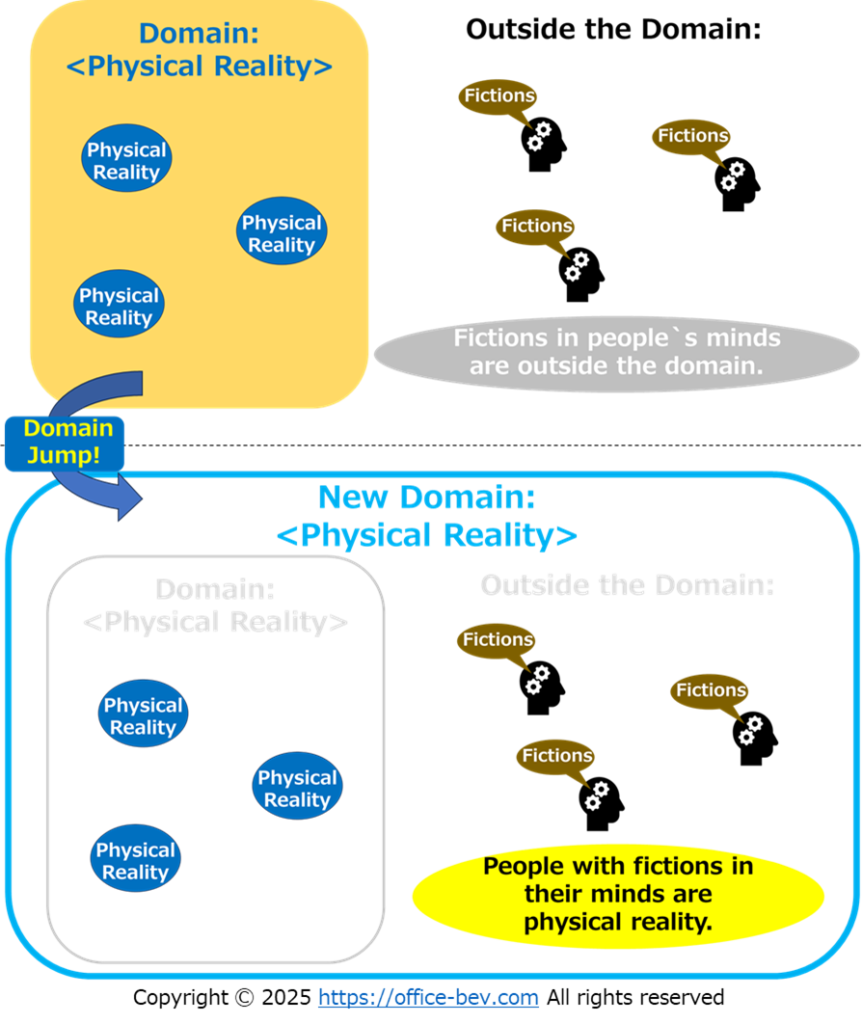
Example B: Creating New Relational Structures
Traditionally, domain A/B (e.g., the relationship between A and B) and domain C/D (the relationship between C and D) existed independently, with no direct connection between A and C.
Before:
- A and B interact within a defined domain A/B.
- C and D interact within a separate domain C/D.
- A and C have no relationship.
By constructing a new fiction (or narrative) that connects A and C, a new domain A/C emerges—”the relationship between A and C.” This shift represents a domain jump, where A and C transition from separate relational frameworks into a newly defined structure.
After:
A and C form a new relational structure, altering both their original domains.
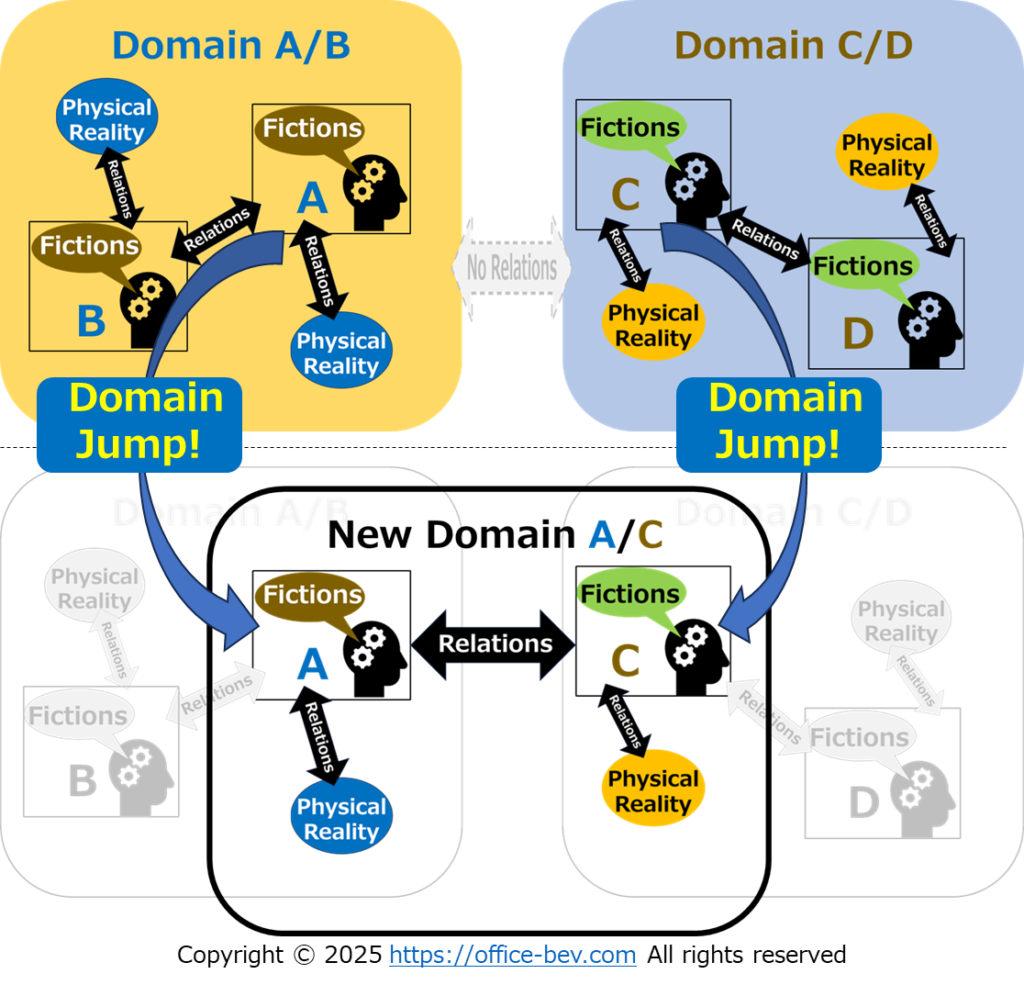
7. Conclusion: A New Way to See the World
The interplay of fiction, domains, and relations forms a dynamic cycle that continuously shapes our world. However, this cycle is not static—domain jumps act as catalysts for paradigm shifts, allowing new perspectives and systems to emerge.
By understanding these processes, we gain not only a new way to interpret the world but also a framework for shaping the future in meaningful ways.
<Diagram Summary>
The following diagram illustrates how the three perspectives introduced in this article—Fiction, Domain of Objects, and Relation—interact with each other and form a continuous loop.
It also highlights how a Domain Jump occurs, showing the two key deviation points where new Relations and new Fictions emerge, leading to paradigm shifts.
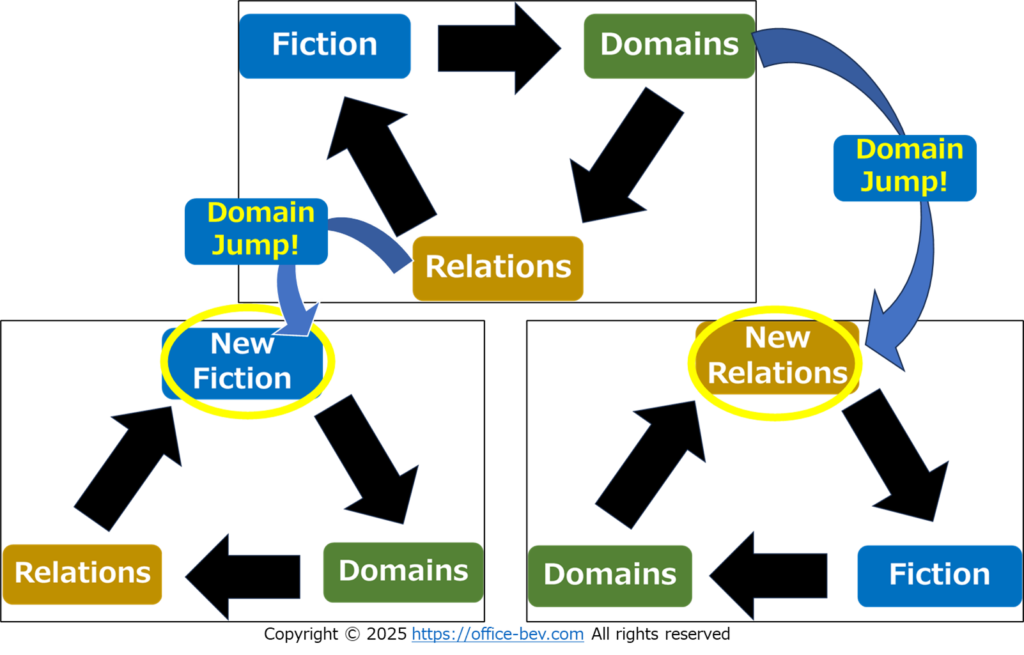

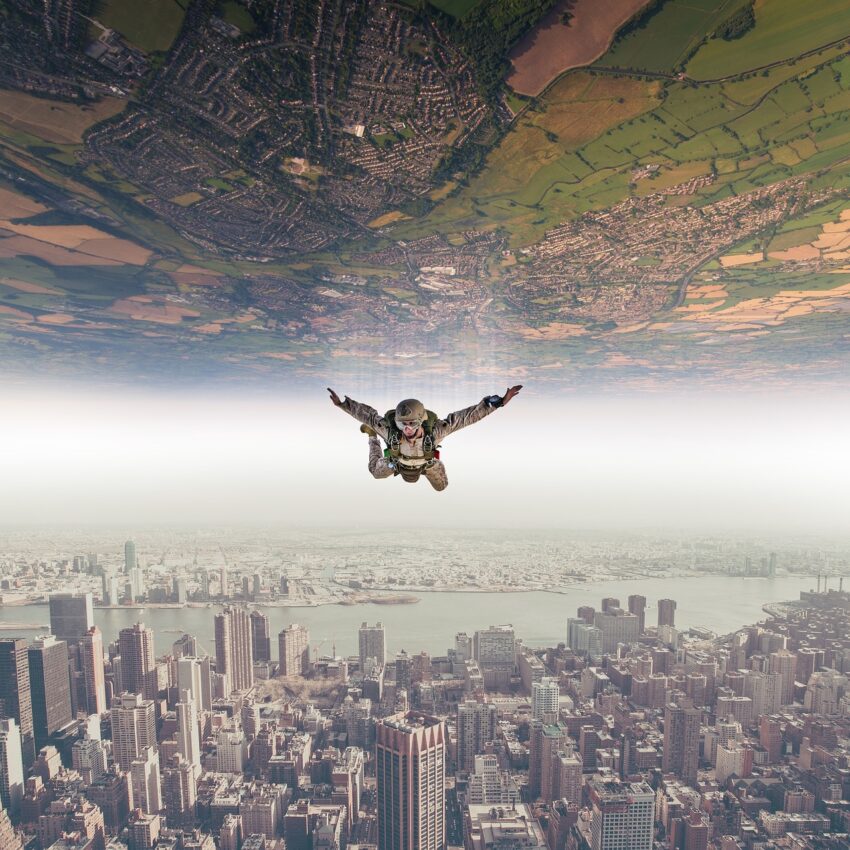
2 thoughts on “Three Perspectives That Change How You See the World”
Comments are closed.